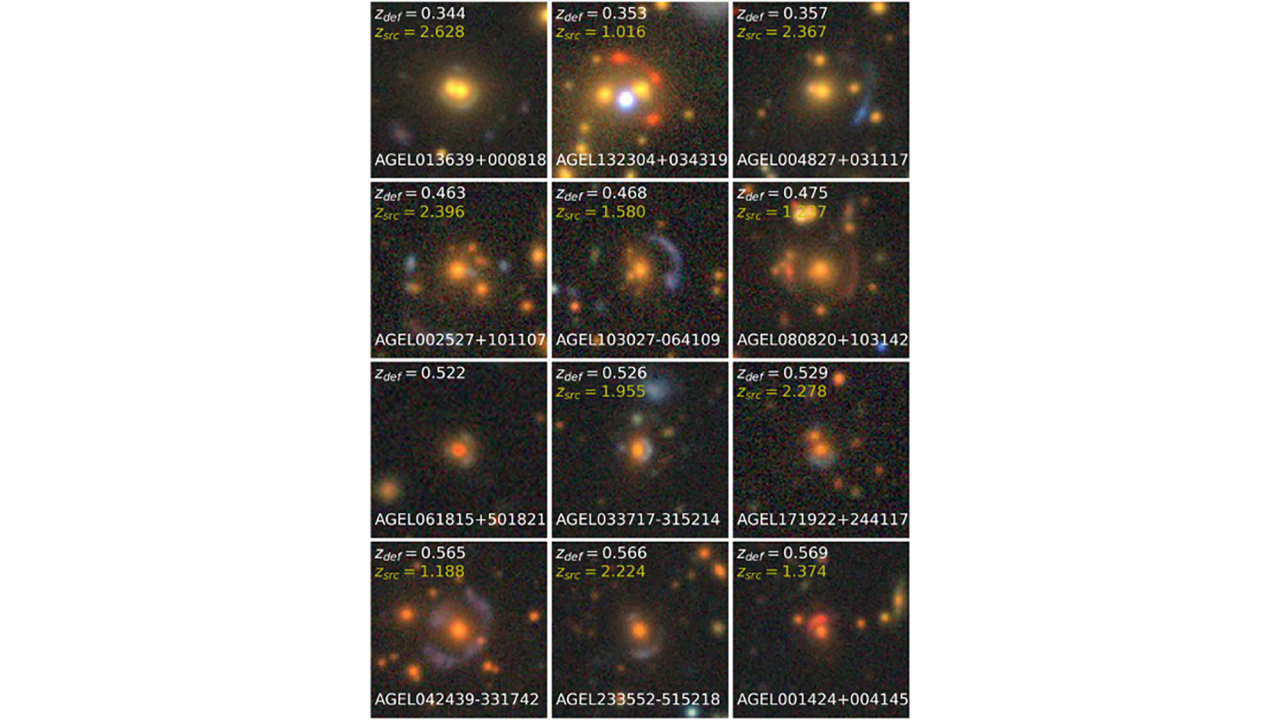An international team of astronomers has discovered dozens of strong gravitational lenses that will allow astronomers to look deep into the universe, revealing ancient structures and giving insight into the nature of dark matter.
Earlier this year, a machine learning algorithm identified up to 5,000 potential gravitational lenses. Now, a team led by Kim-Vy Tran from the University of New South Wales, Sydney and including astronomers at the University of California, Davis has assessed 77 of the potential lenses using the Keck Observatory in Hawai’i and the Very Large Telescope in Chile. The team confirmed that 68 out of the 77 are strong gravitational lenses.
A gravitational lens is an object so massive that light bends around it, in the same way that light bends going through a lens. The phenomenon was predicted by Einstein’s theory of general relativity. These cosmic lenses greatly magnify images of galaxies that we would not otherwise be able to see.
This success rate of 88 per cent suggests that the algorithm is reliable and that we could have thousands of new gravitational lenses. To date, gravitational lenses have been hard to find and only about a hundred are routinely used. The work, part of the ASTRO 3D Galaxy Evolution with Lenses (AGEL) survey, was published Sept. 26 in the Astronomical Journal.
The gravitational lenses were originally identified with convolutional neural networks, a machine learning algorithm developed by Colin Jacobs at ASTRO 3D and Swinburne University of Technology, Melbourne.
“Our spectroscopy allowed us to map a 3D picture of the gravitational lenses to show they are genuine and not merely chance superposition,” Tran said. “Our goal with AGEL is to spectroscopically confirm around 100 strong gravitational lenses that can be observed from both the Northern and Southern hemispheres throughout the year.”
Seeing dark matter
While these lenses let us see objects that are millions of light years away more clearly, they should also let us ‘see’ invisible dark matter that makes up most of the Universe.
“We know that most of the mass is dark,” Tran said. “We know that mass is bending light and so if we can measure how much light is bent, we can then infer how much mass must be there.”
Having many more gravitational lenses at various distances will also give us a more complete image of the timeline going back almost to the Big Bang.
The new sample is “a giant step forward in learning how galaxies form over the history of the universe,” said Tucker Jones, associate professor in the Department of Physics and Astronomy at UC Davis and a co-author on the paper. UC Davis graduate student Keerthi Vasan G. C. and postdoctoral researcher Ryan Sanders also collaborated on the study.
“Normally these early galaxies look like small fuzzy blobs, but the lensing magnification allows us to see their structure with much better resolution. They are ideal targets for our most powerful telescopes to give us the best possible view of the early universe,” Jones said. “Thanks to the lensing effect we can learn what these primitive galaxies look like, what they are made of, and how they interact with their surroundings.”
The study was conducted in collaboration with researchers from the University of New South Wales, Swinburne University of Technology, Australian National University, Curtin University, and the University of Queensland in Australia, the University of Portsmouth, U.K. and the University of Chile. The work was supported in part by the Australian Research Council, Gordon and Betty Moore Foundation and the National Science Foundation.
Media Resources
Bill Condie is a science writer at Science in Public, Australia.
Dozens of Newly Discovered Gravitational Lenses Could Reveal Ancient Galaxies and the Nature of Dark Matter (original news release from the ARC Centre of Excellence for All Sky Astrophysics in 3D, or ASTRO 3D)
Read the paper (Astronomical Journal)
Media Contacts
- Tucker Jones, Physics and Astronomy, tdjones@ucdavis.edu
- Andy Fell, News and Media Relations, 530-304-8888, ahfell@ucdavis.edu
